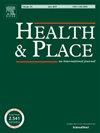Is neighborhood sense of community good for mental health in a pandemic? Paradoxical findings from longitudinal analyses of Wisconsin health survey
IF 4.1
2区 医学
Q1 PUBLIC, ENVIRONMENTAL & OCCUPATIONAL HEALTH
引用次数: 0
Abstract
Social capital is known to function as a protective buffer during disasters and crises. This study examines the relationship between neighborhood-level sense of community–a social capital indicator–and mental health before and after widespread COVID-19 vaccine distribution. It uses health survey data from community-dwelling adults in Wisconsin (n = 2048), a series of longitudinal analyses (Generalized Estimating Equation), adjusting for demographic and socioeconomic status, between neighborhood sense of community and mental health across two timepoints. Before the vaccines, participants with strong sense of community showed significantly lower prevalence of symptoms of depression (PR = 0.81; 95 % CI = 0.70, 0.94; p = 0.004) and anxiety (PR = 0.88; 95 % CI = 0.79, 0.99; p = 0.03), compared to participants with neutral sense of community. After the vaccines, however, the protective effect drastically diminished for both depressive symptoms (PR for interaction = 1.76; 95 % CI = 1.38, 2.25; p < 0.001) and anxiety symptoms (PR for interaction = 1.42; 95 % CI = 1.16, 1.73; p < 0.001). This study yields intriguing and somewhat paradoxical findings that challenge a conventional assumption that social capital–as measured by sense of community at the neighborhood level–protects people during an infectious disease outbreak. The results highlight that neighborhood-level sense of community functioned as a protective buffer early in the pandemic but offered significantly less protection once there was a sense of normalcy with loosened pandemic restrictions and more in-person socializing. Such nuanced results offer insights on the multifaceted nature of social capital, particularly complex and dynamic role of neighborhood sense of community, which may provide insights for future interventions during challenging times.
在大流行期间,社区意识对心理健康有益吗?威斯康星健康调查纵向分析的矛盾结果
众所周知,社会资本在灾难和危机期间起着保护缓冲的作用。本研究探讨了COVID-19疫苗大范围分发前后社区层面社区意识(社会资本指标)与心理健康的关系。它使用了来自威斯康星州社区居住成年人的健康调查数据(n = 2048),一系列纵向分析(广义估计方程),调整了人口和社会经济地位,在两个时间点上社区意识和心理健康之间的关系。在接种疫苗前,社区意识强的参与者抑郁症状的患病率显著降低(PR = 0.81;95% ci = 0.70, 0.94;p = 0.004)和焦虑(PR = 0.88;95% ci = 0.79, 0.99;P = 0.03)。然而,接种疫苗后,对两种抑郁症状的保护作用急剧减弱(相互作用的PR = 1.76;95% ci = 1.38, 2.25;p & lt;0.001)和焦虑症状(相互作用的PR = 1.42;95% ci = 1.16, 1.73;p & lt;0.001)。这项研究产生了一些有趣而有些矛盾的发现,挑战了传统的假设,即社会资本——以社区层面的社区意识衡量——在传染病爆发期间保护人们。研究结果强调,社区层面的社区意识在大流行早期起到了保护缓冲的作用,但一旦有了一种正常的意识,随着大流行限制的放松和更多的面对面社交,社区意识提供的保护就会大大减少。这些微妙的结果提供了对社会资本的多面性的见解,特别是社区意识的复杂和动态作用,这可能为未来在困难时期的干预提供见解。
本文章由计算机程序翻译,如有差异,请以英文原文为准。
求助全文
约1分钟内获得全文
求助全文
来源期刊

Health & Place
PUBLIC, ENVIRONMENTAL & OCCUPATIONAL HEALTH-
CiteScore
7.70
自引率
6.20%
发文量
176
审稿时长
29 days
期刊介绍:
he journal is an interdisciplinary journal dedicated to the study of all aspects of health and health care in which place or location matters.
 求助内容:
求助内容: 应助结果提醒方式:
应助结果提醒方式:


